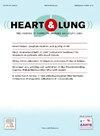评估 Heartfelt 设备在心衰管理中的预测价值:英国多中心 FOOT 试验结果
IF 2.4
4区 医学
Q2 CARDIAC & CARDIOVASCULAR SYSTEMS
引用次数: 0
摘要
目的本研究(NCT04072744)调查了 Heartfelt 设备通过监测外周水肿预测心衰事件的能力,并将其准确性和数据可靠性与传统的每日体重监测进行了比较。该研究旨在确定该设备在向医疗服务提供者、患者和护理人员提供有关即将发生的心力衰竭失代偿的早期警告方面的有效性,并评估调整警报灵敏度是否能改善患者预后,从而确定持续心力衰竭管理的最有效方法。背景Heartfelt设备是一款获得美国食品和药物管理局(FDA)豁免的CE认证设备,可在家中通过使用3D成像和人工智能自主检测外周水肿变化来监测心力衰竭,无需患者输入数据。FOOT 研究在 2020 年 2 月至 2022 年 6 月期间招募了英国五家 NHS 医院的 26 名患者。他们在家中使用 Heartfelt HF3 设备,该设备运行正常,但在记录数据和警报时不会通知患者或医疗团队,以防出现偏差;他们还使用蓝牙体重秤进行每日体重跟踪,这是标准护理的一部分。结果 在使用Heartfelt设备的队列中,8名患者共发生了9起心衰事件,包括2次门诊就诊、6次入院和1次死亡,该设备为病情恶化提供了13天(6.5-20天)的平均前导时间。对于标准护理(每日称重),每周平均有 1.1 天 [0.3-4.1] 的数据,而 Heartfelt 设备每周记录 5.9 天 [4.9-6.6] 的足量数据。在 5 例住院和 1 例死亡之前,Heartfelt 设备在前两周内发出了警报。两起门诊事件发生前也发出了警报;但是,可能是由于阈值过于敏感,设备在此前几周一直每周发出警报,因此门诊事件被算作漏报。尽管在研究过程中患者被告知要遵循定期称重的建议,但大多数患者由于坚持问题而缺乏一致的体重秤数据。结论 Heartfelt 设备在检测表明心衰恶化的外周水肿方面表现出卓越的能力,与传统的体重监测相比,它能提供更可靠的数据收集。尽管可能需要调整灵敏度阈值以优化患者护理效果,但它的预测性警报可能会为临床医生和护理人员提供一个早期预警系统。该设备的关键试验预计将于 2025 年在美国进行。本文章由计算机程序翻译,如有差异,请以英文原文为准。
Assessing the Heartfelt Device's Predictive Value in Heart Failure Management: Findings from the Multicenter FOOT Trial (UK)
Purpose
This study (NCT04072744) investigates the Heartfelt device's ability to predict heart failure events by monitoring peripheral edema, comparing its accuracy and data reliability against traditional daily weight monitoring. It aims to determine the device's effectiveness in providing early warnings to healthcare providers, patients, and caregivers about impending heart failure decompensations and assesses whether adjustments in alert sensitivity could improve patient outcomes, identifying the most efficient approach for ongoing heart failure management.
Background
The Heartfelt device, a CE-marked device covered by FDA exemption, allows heart failure monitoring at home by using 3D imaging and AI to detect peripheral edema changes autonomously, requiring no patient input to collect data. In Europe it is regulated to send alerts on potential heart failure risks to patients, families, or providers based on its findings.
Methods
The FOOT study enrolled 26 patients from five UK NHS hospitals between February 2020 and June 2022. They used the Heartfelt HF3 device at home, which operated normally but logged data and alerts without informing patients or healthcare teams to prevent bias, as well as Bluetooth scales for daily weight tracking as part of standard care. After six months, clinical records were reviewed for heart failure incidents.
Results
In the cohort using the Heartfelt device, 9 heart failure events were recorded in 8 patients, including 2 outpatient visits, 6 hospital admissions, and one fatality, with the device providing an average lead time of 13 days (6.5-20) for deterioration. For standard care (daily weighing), there was an average of 1.1 days [0.3-4.1] of data each week versus 5.9 days [4.9-6.6] of foot volume data weekly recorded by the Heartfelt device. Before 5 of the hospitalizations and one death, the Heartfelt device issued alerts within the preceding two weeks. Alerts also preceded both outpatient incidents; however, the devices had been persistently alerting approximately weekly for several weeks prior, potentially due to excessively sensitive thresholds, so the outpatient events were counted as missed. In total, 6 out of the 9 heart failure events were deemed to be successfully predicted in advance.
Most patients lacked consistent weighing scale data due to adherence issues despite patients being told to follow the advice of regular weighing during the study. Yet, the weight data available indicated that at least 2 events (1 hospitalization and 1 death) could have been predicted.
Conclusion
The Heartfelt device demonstrates superior capability in detecting peripheral edema indicative of heart failure worsening, offering more reliable data collection than traditional weight monitoring. Its predictive alerts potentially afford clinicians and caregivers an early warning system, although adjustments in sensitivity thresholds may be required to optimize patient care outcomes. The pivotal trial for the device is expected to take place in the US in 2025.
求助全文
通过发布文献求助,成功后即可免费获取论文全文。
去求助
来源期刊

Heart & Lung
医学-呼吸系统
CiteScore
4.60
自引率
3.60%
发文量
184
审稿时长
35 days
期刊介绍:
Heart & Lung: The Journal of Cardiopulmonary and Acute Care, the official publication of The American Association of Heart Failure Nurses, presents original, peer-reviewed articles on techniques, advances, investigations, and observations related to the care of patients with acute and critical illness and patients with chronic cardiac or pulmonary disorders.
The Journal''s acute care articles focus on the care of hospitalized patients, including those in the critical and acute care settings. Because most patients who are hospitalized in acute and critical care settings have chronic conditions, we are also interested in the chronically critically ill, the care of patients with chronic cardiopulmonary disorders, their rehabilitation, and disease prevention. The Journal''s heart failure articles focus on all aspects of the care of patients with this condition. Manuscripts that are relevant to populations across the human lifespan are welcome.
 求助内容:
求助内容: 应助结果提醒方式:
应助结果提醒方式:


